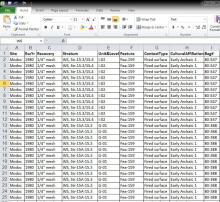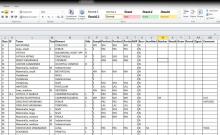The best way to store and analyze faunal data is to enter it into an electronic database. This practice helps preserve the information and makes tabulation and analyses of the data easier. For our grant project some of the pre-1975 faunal data for the Koster site, was only recorded on paper worksheets. We entered these data into an Excel file. For Modoc Rock Shelter, the faunal data for the 1950s excavations were only recorded on paper. All that was recorded was the species, element, and sometimes the side.
Fortunately we had previously selected samples of the faunal remains excavated in the 1950s and had re-identified them. We then recorded a broader suite of data comparable to that collected in the 1980s into an electronic database. Some of the 1980s specialty analyses for Modoc such as those for snails were only recorded on paper. We entered those data into Excel files and uploaded them on our computers and into the Digital Archaeological Record.
Most of the 1980s data for Modoc and Koster had been entered into electronic databases. However, we had to convert these databases from older media, such as floppy disks, to more modern media that our computers could read. Fortunately, the Illinois State Museum curated an ancient computer with a floppy disk drive that was able to read and convert our floppy disks.
All of the datasets for our grant project are now stored at the Illinois State Museum and Indiana University of Pennsylvania in modern formats that are readable on desktops and laptops. The electronic datasets that we retrieved primarily retained their original coding formats. However, we did clean up and add information to these databases.
For example, if the comments column included data that had been systematically recorded for several attributes, then we entered that information into separate columns so it could be tabulated and analyzed. We also added columns to give the name of the site, the cultural affiliation, and context (e.g., midden or feature) if this information had not been included. We saved these datasets, but they must be continually ported up to new media or they could be lost again.
The coding forms for recording information on faunal remains in an electronic database often include most of the same variables, such as taxon, burning, and fragmentation. However, the codes for attributes for each variable varied among researchers. For example, burning might have been recorded as unburned, red, black, or calcined or simply recorded as unburned, lightly burned, or heavily burned. The coding options for attributes for each variable should be specified and selected from a written document.
We were able to figure out most of the codes that had been used for early work at Modoc Rock Shelter and Koster because we had written documentation and had worked with the researchers who originally identified the faunal remains.
The table below shows the kinds of information that are usually recorded in a faunal database. As noted above, the specific attributes for each variable vary among faunal analysts. Most analysts have a coding format that provides the variables and attributes for each variable. It is important to preserve the coding format so future researchers can understand and interpret the coding. The data may be entered onto tags or paper forms or directly into an electronic database management program or spreadsheet.
| Variable | Attributes |
|---|---|
| Site Name and Year of Excavation | Number and/or name of the site and the year of excavation |
| Bag or Catalog Number | Number assigned to the excavated sample |
| Test Unit | Number, letter, or grid locus for the excavation unit |
| Test Unit Level | Excavation level in the test unit (numbered from top to bottom) |
| Feature | Number or letter assigned to a structural feature, such as a pit |
| Feature Level | Excavation level in the feature (numbered from top to bottom) |
| Stratum or Horizon | Number or letter assigned to designate a natural or cultural deposit, e.g., Stratum 12, Horizon 11 |
| Cultural Affiliation | Cultural period assigned to the deposit, e.g., early Middle Archaic |
| Recovery Method | Method of recovery and mesh size, e.g., screened-1/4" mesh |
| Sample Size | Size of the analyzed sample of bone, e.g., whole sample, 1/4 subsample |
| Class of Animal | Mammal, bird, reptile, amphibian, fish, indeterminate vertebrate, bivalve, gastropod, invertebrate, unknown |
| Taxon | Identification to the finest level possible, e.g., family, genus, or genus and species |
| Referral | Designation of "cf." (compares favorably to) to indicate that the identification was not definite |
| Body Size or Fish Length | Gross body size designation (e.g., small, medium, or large) or 8 cm grouped standard length estimate for fish |
| Element | Name of the bone or shell (e.g., humerus, radius, valve for freshwater mussel) |
| Portion | Part of the bone or shell present (e.g., proximal, distal, shaft, ventral) |
| Side | Symmetry (side) of the body (e.g, right, left, unknown or left blank if not applicable) |
| Completeness | Amount of bone present, often in quarters from <1/4 to whole |
| Burning | Intensity of burning (e.g., unburned, red, black, calcined) |
| Human Modification | Notation of marks related to food processing or artifact manufacture and/or use, e.g., cuts, ground, incised |
| Condition or Weathering | Notation of condition of bone (e.g., good, bad, weathered or weathering stage) |
| Chewing or Gnawing | Notation of gnawing by rodents and/or chewing by carnivores |
| Digestion | Notation of digested bone, e.g. acid pitted and rounded) |
| Rounding | Notation of rounding due to water rolling |
| Number of Specimens Identical for all Attributes | Count of all the bones that share all of the same attributes and are coded on one line |
| Comments | Additional comments on estimated age of animal, sex, epiphysis closure, seasonality indicators, human modifications, artifact types, etc. |
| Name of Analyst | Name of the person who identified the animal bones |
The screen shots below provide examples of the faunal data that was coded for the 1980 excavations at Modoc Rock Shelter.




